AUCTORES
Globalize your Research
Case Report | DOI: https://doi.org/10.31579/2690-1897/025
1 Oral and Maxillofacial surgeon at General Hospital “Dr. Darío Fernández Fierro” ISSSTE. México.
2 Dentist General Practice
3 Third year resident in Oral and Maxillofacial Surgery.
4 Second year resident in General Surgery.
5 First year resident in General Surgery.
*Corresponding Author: Jorge Carrillo Rivera. Dpto. de Cirugía Maxilofacial Hosp. Gral. Dr. Darío Fernández. ISSSTE. Consultorio particular.
Citation: Jorge Arnulfo C R, Quiñones R René, José Ricardo M P, Víctor Omar G H, Annel Ivonne G L. (2020) Blood loss and Procedure Time in Major Salivary Glands Benign Tumors Resection Using Harmonic Scalpel. Journal of Surgical Case Reports and Images, 3(3): Doi: 10.31579/2690-1897/025c
Copyright: © 2020. Jorge Carrillo Rivera. This is an open-access article distributed under the terms of the Creative Commons Attribution License, which permits unrestricted use, distribution, and reproduction in any medium, provided the original author and source are credited.
Received: 04 March 2020 | Accepted: 10 March 2020 | Published: 16 March 2020
Keywords: ultrasonic vibration; minimally invasive surgery; head and neck; benign tumors; whartin tumor; lipoma; oncocitoma
Ultrasonic vibration is mainly used in minimally invasive surgery since it uses longitudinal mechanical waves with the ability to propagate in a solid and liquid medium, conducted to the tissues through an active tip, a large amount of vibrational energy is produced at the point of contact getting the section, coagulation and dissection of tissue.
Objective. To evaluate the operating time and blood loss in major salivary glands benign tumors resection using harmonic scalpel during the period from August 2018 to March 2019 at the Dr. Darío Fernández General Hospital.
Material and methods. Twelve patients with benign salivary gland tumors of both sexes between 39 and 76 years of age were included for the study, time and intraoperative bleeding were quantified and analyzed with measures of central tendency.
Results: The most frequently performed surgery was submaxilectomy (50%), followed by superficial parotidectomy (33.3%) and submaxilectomy plus lymph node resection (16.6%). The intraoperative time lasted from 20 to 65 minutes with an average 44.16 minutes, bleeding in milliliters ranged from 25 to 60 milliliters with a mean of 42. 9 ml.
Conclusions: The use of ultrasonic vibration significantly reduces operating time and blood loss due to coagulation and cutting simultaneously with less heat production.
The hemostasis systems applied in surgery are based on the production of endothermic heat as a result of an interaction between energy and tissue [1]. Progressively more sophisticated electrocoagulation systems such as the ultrasonic scalpel based on the protein's destructiveness have been developed of the cell membrane as a result of ultrasonic vibration, generating significantly low temperatures (50 to 100 ° C) compared to the electro cautery (100 to 150 ° C) .3 It is an apparatus that uses mechanical energy to cauterize the vessels and dissect the tissues; It consists of three components, a generator that provides electricity, this is transformed into energy through a system of piezoelectric crystals that vibrate in an amplitude between 50 to 330 µm, at a constant frequency between 23 to 55.5 kHz, the expansion and contraction of These crystals are sent by means of a handpiece that attaches to the active tip either to a scalpel or to scissors [2,3]. Figure 1.
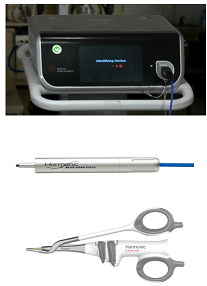
Ultrasonic coagulation is similar to that of the electrocautery, however, the mechanism by which the protein is denatured is due to the transfer of mechanical energy, breaking the tertiary hydrogen bonds, the protein tissue is transformed into a viscous collagen that cauterizes the small and medium diameter vessels [3,4].
There are two mechanisms by which tissues are dissected, one is by means of cavitation fragmentation and the second by mechanical cutting at temperatures below 63 ° C; Vibration defragments proteins with the breakdown of hydrogen bonds (tertiary hydrogen bonds). It can be used simultaneously for cutting and coagulation, since it transfers the neuromuscular current and produces a minimal lateral thermal effect (1 to 3 mm). After cutting and coagulation, it causes minimal intraoperative bleeding, which allows the surgeon a better view of the operative field, so the surgery lasts less time than with other techniques and causes minimal tissue damage, which leads to scarring of faster wounds, lower postoperative morbidity and decreased postoperative pain [2, 4 and 5].
The surgical time is known as the time in minutes used in the surgical procedure obtained from the anesthesiology report sheet, from the beginning of the surgical incision in the skin to the closure of it. The trans-surgical bleeding defined as the volume of bleeding in milliliters reported on the anesthesiology sheet resulting from the count in the aspiration manifold and the estimation by gauze used. Over the years, various methods have been reported for the quantification of intraoperative bleeding, some of these methods are considered impractical and obsolete. According to current literature, visual estimation is the most widely used method despite its low accuracy [6].
The quantification of bleeding by the weight of textiles is considered the most practical and accurate method to determine the amount of blood not captured in the containers, which is obtained by subtracting the dry weight of absorbent textiles and the weight of textiles with blood material, using the conversion of 1g = 1ml [6].
This is a 54-year-old male patient, with a 3-year hemifacial asymmetry of evolution in the right buccal region of slow growth, asymptomatic, soft consistency and well-defined edges, not hyperemic or hyper thermic. With a history of uncontrolled systemic arterial hypertension, osteoarthritis and gonartrosis of the left lower limb, on treatment based on pregabalin and etoricoxib 1 tablet every 24 hours. In the simple tomography, a hypo dense area was observed in the circumscribed right oral space of 6 x 5 centimeters. Figure 2

Intraoral fine needle aspiration biopsy (BAAF) of the lesion was performed and the lamellae were sent to the pathology laboratory where mature adipose tissue with lymphocyte infiltrate and surrounded by fibrous stroma with a diagnostic interpretation compatible with lipoma was reported. Figures 3 A and B.
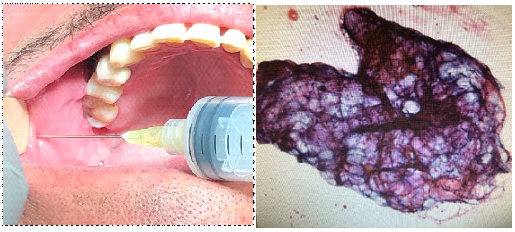
Tumor resection was performed under balanced general anesthesia with orotracheal intubation, through a preauricular approach with submandibular extension of approximately five centimeters, dissection by planes and coagulation of small and medium caliber vessels through the use of ultrasonic vibration scissors until reaching the lesion, respecting the integrity of the parotid gland, as well as the marginal branch of the facial nerve, the tumor was removed, the hemostasis of the surgical bed was verified and it was sutured by planes. Figure 4.
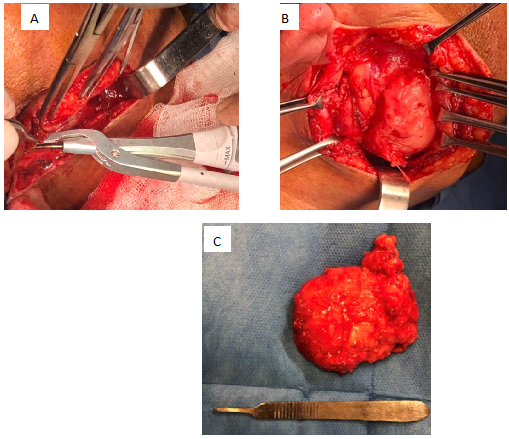
In the histological sections, a lesion of mesenchymal line was seen, formed by broad lobes of mature adipose tissue, separated by delicate septum of well-vascularized lax fibrous tissue and well delimited by a thin layer of mature fibrous tissue, compatible with lipoma.
A 58-year-old female patient with a history of controlled type II diabetes, with a two-year increase in volume in the left parotid region of slow growth, firm consistency, subject to deep planes, with a diameter of four centimeters, not painful to palpation Requesting preoperative studies, salivary gland ultrasonography, reporting hypercoic area dependent on the left parotid gland, with presence of adjacent nodes and increased vascularity. Simple and contrasted computed tomography observing a hyper dense area of soft tissue with proximity to the carotid sheath and lymph nodes present, with a diagnostic impression of parotid gland tumor of the superficial lobe, lymphadenopathy and increased vascularity (Figure 5.)

Fine needle aspiration biopsy (BAAF) was performed, reporting polymorphonuclear cells with metaplastic changes in the epithelium, with a positive diagnostic interpretation of Whartin tumor.
Under balanced general anesthesia orotracheal intubation, prior asepsis and antisepsis, a three-centimeter submandibular approach was designed with pre and retroauricular extension, dissection of superficial cervical fascia and coagulation of small and medium-sized vessels with ultrasonic vibration scissors, appreciating tumor in Left parotid space approximately four centimeters in diameter, respecting the marginal branch of the nerve and facial vein, tumor resection is performed, sending tissue to a pathological study with a diagnosis of Whartin's tumor, observing a surgical bed without bleeding data, suturing by planes. (Figure 6).
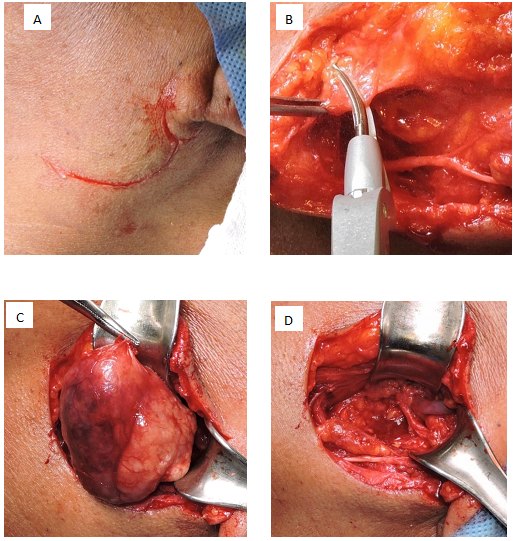
Twelve patients of both sexes, between 39 and 76 years of age (mean of 57.5 years) admitted with a diagnosis of benign salivary gland tumor and cervical lymphadenopathy under study, for resection and / or excisional biopsy under general anesthesia were included for the study in the period from August 2018 to March 2019. A descriptive, longitudinal study was carried out. Inclusion criteria for patients of both sexes with controlled systemic disease, no neoplastic history and previous diagnosis by fine needle aspiration biopsy of benign tumor in major salivary glands and cervical lymphadenopathy of inflammatory origin. Exclusion criteria: patients with uncontrolled systemic diseases, with a history of malignant neoplastic tumors, with chemotherapy or prior radiotherapy. Elimination criteria, subjects who did not attend their appointments or who did not authorize the study. The procedure was performed under general anesthesia with orotracheal intubation and by extraoral approach, dissection with harmonic scissors of Harmonic brand, FocusMR (Johnson & Johnson).7 the trans-surgical time was quantified in minutes from the incision until the suture of the surgical wound was finished. , the bleeding was quantified in milliliters.Table1.
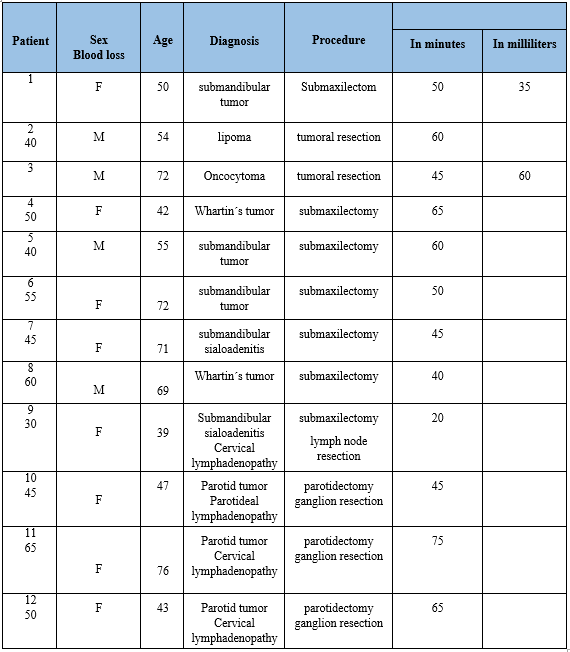
the results obtained were captured in an Excel spreadsheet and evaluated through the SPSS program to know measures of central tendency.
Of the twelve patients included in the study, 3 (25%) were male and 9 (75%) female, the most frequent diagnosis was benign submandibular gland tumor (33.3%), followed by cervical lymphadenopathy (25%), submandibular sialoadenitis (25%), parotid lymphadenopathy (8.3%), and lipoma (8.3%), the most frequently performed surgery was submaxilectomy (50%), followed by superficial parotidectomy (33.3%) and lymph node resection ( 16.6%). Table 2.
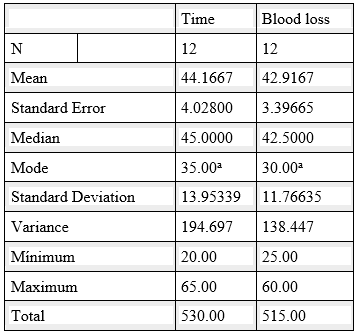
There is no significant correlation between bleeding presented by the 12 patients with the time of the surgical procedure. There was greater bleeding in patients undergoing parotidectomy, in relation to those of submaxilectomy. Graphic 1.
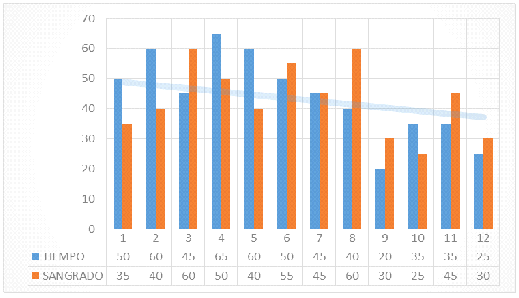
The intraoperative time lasted from 20 to 65 minutes with an average 44.16 minutes. Graphic 2.
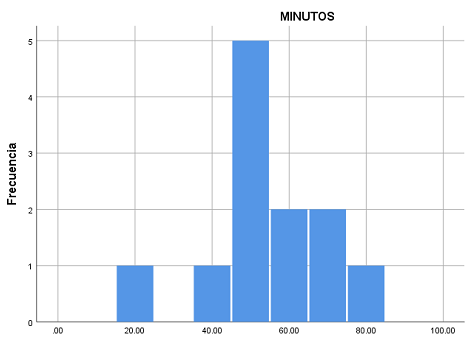
Bleeding ranged from 25 to 60 milliliters with an average of 42. 9 milliliters. Graphic 3.
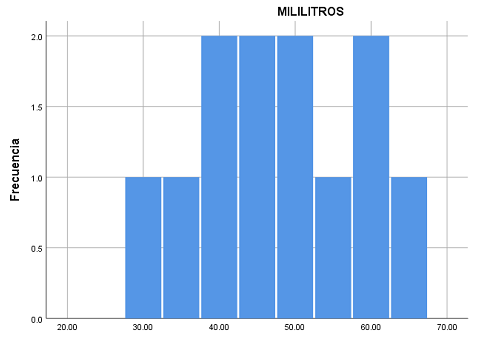
Ultrasonic coagulation is a surgical tool, implemented in head and neck surgery since 1991. The ultrasonic vibration scissors, consist of a vibrating blade that oscillates at a frequency of 55.5 kHz and a temperature that does not exceed 100°C [8, 9].
Fan et al. demonstrated the use of ultrasonic vibration scissors for the resection of benign lesions at the base of the tongue through the transoral approach, reducing surgical duration and Tran’s operative hemorrhage [10].
Koh et al mentioned less damage to nerve structures in neck dissections using ultrasonic vibration than with the use of electrosurgery [11].
The coagulation of the tissue originates through the denaturation of proteins, breaking the hydrogen bonds due to the high vibrational energy transferred to the tissue with the ultrasonic energy. Due to the absence of high temperatures, the tissue does not boil or carbonize, it simply bleaches and coagulates [12, 14].
Currently, a decrease in operative time has been reported in the world literature, as well as a significant decrease in hemorrhagic complications in the Trans and postoperative period through the use of ultrasonic vibration instruments in head and neck surgery [15, 19].
the harmonic scalpel (HS) (Ethicon, Somerville, NJ), an instrument that uses ultrasonic vibrations to induce tissue cutting and immediate coagulation, was introduced in the early 1990s [7, 10].
A low power setting allows for greater hemostasis and a slower cut, while a high power setting offers less hemostasis but a faster cutting capacity. Ultrasonic vibration has been shown to reduce operative time and intraoperative blood loss in a range of procedures including from thyroidectomy, parotidectomy, glosectomy and neck dissection [15, 18].
According to the data obtained, it can be concluded that the time and trans operative bleeding decrease considerably with the use of ultrasonic vibration, coinciding with that reported by the articles reviewed [19,20].
Clearly Auctoresonline and particularly Psychology and Mental Health Care Journal is dedicated to improving health care services for individuals and populations. The editorial boards' ability to efficiently recognize and share the global importance of health literacy with a variety of stakeholders. Auctoresonline publishing platform can be used to facilitate of optimal client-based services and should be added to health care professionals' repertoire of evidence-based health care resources.

Journal of Clinical Cardiology and Cardiovascular Intervention The submission and review process was adequate. However I think that the publication total value should have been enlightened in early fases. Thank you for all.

Journal of Women Health Care and Issues By the present mail, I want to say thank to you and tour colleagues for facilitating my published article. Specially thank you for the peer review process, support from the editorial office. I appreciate positively the quality of your journal.
Journal of Clinical Research and Reports I would be very delighted to submit my testimonial regarding the reviewer board and the editorial office. The reviewer board were accurate and helpful regarding any modifications for my manuscript. And the editorial office were very helpful and supportive in contacting and monitoring with any update and offering help. It was my pleasure to contribute with your promising Journal and I am looking forward for more collaboration.

We would like to thank the Journal of Thoracic Disease and Cardiothoracic Surgery because of the services they provided us for our articles. The peer-review process was done in a very excellent time manner, and the opinions of the reviewers helped us to improve our manuscript further. The editorial office had an outstanding correspondence with us and guided us in many ways. During a hard time of the pandemic that is affecting every one of us tremendously, the editorial office helped us make everything easier for publishing scientific work. Hope for a more scientific relationship with your Journal.

The peer-review process which consisted high quality queries on the paper. I did answer six reviewers’ questions and comments before the paper was accepted. The support from the editorial office is excellent.

Journal of Neuroscience and Neurological Surgery. I had the experience of publishing a research article recently. The whole process was simple from submission to publication. The reviewers made specific and valuable recommendations and corrections that improved the quality of my publication. I strongly recommend this Journal.

Dr. Katarzyna Byczkowska My testimonial covering: "The peer review process is quick and effective. The support from the editorial office is very professional and friendly. Quality of the Clinical Cardiology and Cardiovascular Interventions is scientific and publishes ground-breaking research on cardiology that is useful for other professionals in the field.

Thank you most sincerely, with regard to the support you have given in relation to the reviewing process and the processing of my article entitled "Large Cell Neuroendocrine Carcinoma of The Prostate Gland: A Review and Update" for publication in your esteemed Journal, Journal of Cancer Research and Cellular Therapeutics". The editorial team has been very supportive.

Testimony of Journal of Clinical Otorhinolaryngology: work with your Reviews has been a educational and constructive experience. The editorial office were very helpful and supportive. It was a pleasure to contribute to your Journal.

Dr. Bernard Terkimbi Utoo, I am happy to publish my scientific work in Journal of Women Health Care and Issues (JWHCI). The manuscript submission was seamless and peer review process was top notch. I was amazed that 4 reviewers worked on the manuscript which made it a highly technical, standard and excellent quality paper. I appreciate the format and consideration for the APC as well as the speed of publication. It is my pleasure to continue with this scientific relationship with the esteem JWHCI.

This is an acknowledgment for peer reviewers, editorial board of Journal of Clinical Research and Reports. They show a lot of consideration for us as publishers for our research article “Evaluation of the different factors associated with side effects of COVID-19 vaccination on medical students, Mutah university, Al-Karak, Jordan”, in a very professional and easy way. This journal is one of outstanding medical journal.
Dear Hao Jiang, to Journal of Nutrition and Food Processing We greatly appreciate the efficient, professional and rapid processing of our paper by your team. If there is anything else we should do, please do not hesitate to let us know. On behalf of my co-authors, we would like to express our great appreciation to editor and reviewers.

As an author who has recently published in the journal "Brain and Neurological Disorders". I am delighted to provide a testimonial on the peer review process, editorial office support, and the overall quality of the journal. The peer review process at Brain and Neurological Disorders is rigorous and meticulous, ensuring that only high-quality, evidence-based research is published. The reviewers are experts in their fields, and their comments and suggestions were constructive and helped improve the quality of my manuscript. The review process was timely and efficient, with clear communication from the editorial office at each stage. The support from the editorial office was exceptional throughout the entire process. The editorial staff was responsive, professional, and always willing to help. They provided valuable guidance on formatting, structure, and ethical considerations, making the submission process seamless. Moreover, they kept me informed about the status of my manuscript and provided timely updates, which made the process less stressful. The journal Brain and Neurological Disorders is of the highest quality, with a strong focus on publishing cutting-edge research in the field of neurology. The articles published in this journal are well-researched, rigorously peer-reviewed, and written by experts in the field. The journal maintains high standards, ensuring that readers are provided with the most up-to-date and reliable information on brain and neurological disorders. In conclusion, I had a wonderful experience publishing in Brain and Neurological Disorders. The peer review process was thorough, the editorial office provided exceptional support, and the journal's quality is second to none. I would highly recommend this journal to any researcher working in the field of neurology and brain disorders.

Dear Agrippa Hilda, Journal of Neuroscience and Neurological Surgery, Editorial Coordinator, I trust this message finds you well. I want to extend my appreciation for considering my article for publication in your esteemed journal. I am pleased to provide a testimonial regarding the peer review process and the support received from your editorial office. The peer review process for my paper was carried out in a highly professional and thorough manner. The feedback and comments provided by the authors were constructive and very useful in improving the quality of the manuscript. This rigorous assessment process undoubtedly contributes to the high standards maintained by your journal.

International Journal of Clinical Case Reports and Reviews. I strongly recommend to consider submitting your work to this high-quality journal. The support and availability of the Editorial staff is outstanding and the review process was both efficient and rigorous.

Thank you very much for publishing my Research Article titled “Comparing Treatment Outcome Of Allergic Rhinitis Patients After Using Fluticasone Nasal Spray And Nasal Douching" in the Journal of Clinical Otorhinolaryngology. As Medical Professionals we are immensely benefited from study of various informative Articles and Papers published in this high quality Journal. I look forward to enriching my knowledge by regular study of the Journal and contribute my future work in the field of ENT through the Journal for use by the medical fraternity. The support from the Editorial office was excellent and very prompt. I also welcome the comments received from the readers of my Research Article.

Dear Erica Kelsey, Editorial Coordinator of Cancer Research and Cellular Therapeutics Our team is very satisfied with the processing of our paper by your journal. That was fast, efficient, rigorous, but without unnecessary complications. We appreciated the very short time between the submission of the paper and its publication on line on your site.

I am very glad to say that the peer review process is very successful and fast and support from the Editorial Office. Therefore, I would like to continue our scientific relationship for a long time. And I especially thank you for your kindly attention towards my article. Have a good day!

"We recently published an article entitled “Influence of beta-Cyclodextrins upon the Degradation of Carbofuran Derivatives under Alkaline Conditions" in the Journal of “Pesticides and Biofertilizers” to show that the cyclodextrins protect the carbamates increasing their half-life time in the presence of basic conditions This will be very helpful to understand carbofuran behaviour in the analytical, agro-environmental and food areas. We greatly appreciated the interaction with the editor and the editorial team; we were particularly well accompanied during the course of the revision process, since all various steps towards publication were short and without delay".

I would like to express my gratitude towards you process of article review and submission. I found this to be very fair and expedient. Your follow up has been excellent. I have many publications in national and international journal and your process has been one of the best so far. Keep up the great work.

We are grateful for this opportunity to provide a glowing recommendation to the Journal of Psychiatry and Psychotherapy. We found that the editorial team were very supportive, helpful, kept us abreast of timelines and over all very professional in nature. The peer review process was rigorous, efficient and constructive that really enhanced our article submission. The experience with this journal remains one of our best ever and we look forward to providing future submissions in the near future.

I am very pleased to serve as EBM of the journal, I hope many years of my experience in stem cells can help the journal from one way or another. As we know, stem cells hold great potential for regenerative medicine, which are mostly used to promote the repair response of diseased, dysfunctional or injured tissue using stem cells or their derivatives. I think Stem Cell Research and Therapeutics International is a great platform to publish and share the understanding towards the biology and translational or clinical application of stem cells.

I would like to give my testimony in the support I have got by the peer review process and to support the editorial office where they were of asset to support young author like me to be encouraged to publish their work in your respected journal and globalize and share knowledge across the globe. I really give my great gratitude to your journal and the peer review including the editorial office.

I am delighted to publish our manuscript entitled "A Perspective on Cocaine Induced Stroke - Its Mechanisms and Management" in the Journal of Neuroscience and Neurological Surgery. The peer review process, support from the editorial office, and quality of the journal are excellent. The manuscripts published are of high quality and of excellent scientific value. I recommend this journal very much to colleagues.

Dr.Tania Muñoz, My experience as researcher and author of a review article in The Journal Clinical Cardiology and Interventions has been very enriching and stimulating. The editorial team is excellent, performs its work with absolute responsibility and delivery. They are proactive, dynamic and receptive to all proposals. Supporting at all times the vast universe of authors who choose them as an option for publication. The team of review specialists, members of the editorial board, are brilliant professionals, with remarkable performance in medical research and scientific methodology. Together they form a frontline team that consolidates the JCCI as a magnificent option for the publication and review of high-level medical articles and broad collective interest. I am honored to be able to share my review article and open to receive all your comments.

“The peer review process of JPMHC is quick and effective. Authors are benefited by good and professional reviewers with huge experience in the field of psychology and mental health. The support from the editorial office is very professional. People to contact to are friendly and happy to help and assist any query authors might have. Quality of the Journal is scientific and publishes ground-breaking research on mental health that is useful for other professionals in the field”.

Dear editorial department: On behalf of our team, I hereby certify the reliability and superiority of the International Journal of Clinical Case Reports and Reviews in the peer review process, editorial support, and journal quality. Firstly, the peer review process of the International Journal of Clinical Case Reports and Reviews is rigorous, fair, transparent, fast, and of high quality. The editorial department invites experts from relevant fields as anonymous reviewers to review all submitted manuscripts. These experts have rich academic backgrounds and experience, and can accurately evaluate the academic quality, originality, and suitability of manuscripts. The editorial department is committed to ensuring the rigor of the peer review process, while also making every effort to ensure a fast review cycle to meet the needs of authors and the academic community. Secondly, the editorial team of the International Journal of Clinical Case Reports and Reviews is composed of a group of senior scholars and professionals with rich experience and professional knowledge in related fields. The editorial department is committed to assisting authors in improving their manuscripts, ensuring their academic accuracy, clarity, and completeness. Editors actively collaborate with authors, providing useful suggestions and feedback to promote the improvement and development of the manuscript. We believe that the support of the editorial department is one of the key factors in ensuring the quality of the journal. Finally, the International Journal of Clinical Case Reports and Reviews is renowned for its high- quality articles and strict academic standards. The editorial department is committed to publishing innovative and academically valuable research results to promote the development and progress of related fields. The International Journal of Clinical Case Reports and Reviews is reasonably priced and ensures excellent service and quality ratio, allowing authors to obtain high-level academic publishing opportunities in an affordable manner. I hereby solemnly declare that the International Journal of Clinical Case Reports and Reviews has a high level of credibility and superiority in terms of peer review process, editorial support, reasonable fees, and journal quality. Sincerely, Rui Tao.

Clinical Cardiology and Cardiovascular Interventions I testity the covering of the peer review process, support from the editorial office, and quality of the journal.
